The Ancient Way
Traveling by foot is usually the best and is certainly the oldest way to get to know a place. But covering a lot of ground by foot requires that we care for our feet. With so many choices these days it is easy to choose the wrong kind of footwear. That leads to having a bad experience because of discomfort, which might end your exploration. The choices in shoes we face range from completely utilitarian to very pleasing to the eye but totally impractical to wear beyond our front door. The sheer number of varients can make it easy to make a bad choice.
This is a guide to help you find the right shoes for hiking and exploring.
There are two basic categories:
- Hiking Shoes
- Hiking Boots
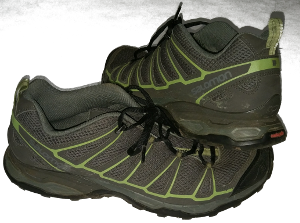 Shoes for Hiking and Trail Runners
Shoes for Hiking and Trail Runners
Hiking shoes are lighter duty and do not have mid to high uppers, meaning they do not cover the ankles. They range from ultra light trail runners to much beefier leather shoes with thick soles.
Trail runners
Trail runners are a new spin on an ancient design. The moccasins used by indians were used to protect the feet and had evolved into very effective footwear. They were light and they provided a feel for the ground. Trail runners are a high tech variant of moccasins, they are lightweight, and designed for runners not hikers.
Trail runners are often water resistant, breathable with thinner soles than their hiking counterparts. They are quite light and comfortable and require no break in period. Trail runners provide a level of agility that most hiking shoe do not. Trail runners do not offer the protection of a heavier hiking shoe however. The toes and ankles are more vulnerable to bruising from rocks and sticks and they provide no protection from ankle sprains and breaks. Those who practice super lightweight hiking generally choose to wear these type of shoes. They are not recommended for beginning hikers. It takes time to become trail savvy and there is a learning curve involved in learning to walk on difficult harsh terrain.
I really like trail runners, and I use them almost exclusively for hiking. I like being able to feel the bumps, sticks and contours of the rocks I am walking or climbing on although I have bruised my heels walking on rocky terrain. And I have had problems in the desert with thorns penetrating the shoe and my foot. So in the desert, I will wear a heavier shoe.
Hiking Shoes
Hiking shoes are a compromise between the newer lightwieght trail runners and hiking boots. They are sturdier and have heavier soles. They provide better protection for toes and feet, but not much protection for ankles. The thicker sole and uppers protect feet from sticks, thorns and sharp rocks. Hiking shoes are lighter than boots and a good choice for hiking, but they are still risky for backpacking because of the lack of ankle support. This problem is amplified by the load you are carrying.
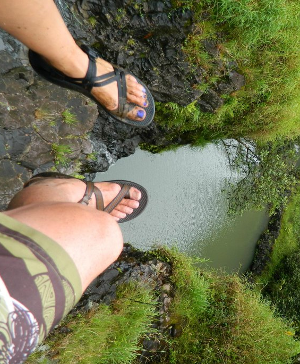 Specialized shoes
Specialized shoes
I have used high end flip flops to go places that, with hindsight, were probably unwise. But they fit well, and had vibram soles, so I was able to get away with it. Water is one of the big drivers of specialized shoes for hiking. It used to be if you knew you would be hiking in a creek you would wear your beat up tennis shoes. So, the problem was they did not dry quickly and it can be miserable hiking in soggy tennis shoes. There has been a lot of innovation in water foot wear. There are tough flip flops, water sandals, climbing water shoes etc. It is beyond the scope of this article to cover these. However, i will mention there are some great products out there, like my chaco flip flops.
There are also shoes for climbing, riding and so on. The new trend is to create hybrids. An example is approach shoes, these are suitable for light climbing and hiking.
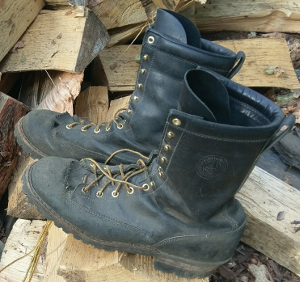
Boots
Hiking boots have higher uppers are stiffer and offer more foot support than hiking shoes. They can have very high tops and be useful for work, forestry, or punk rock shows.
Hiking Boots
Made for day hikes and short backpacking trips. Hiking boots are lighter and have less break in time than a backpacking boot. Breakin is used to allow the boot to contour to your foot. Although with some boots, like firefighting boots, it is said that breakin allows your foot to contour to the boot.
Hiking boots are continually improving. They are becoming lighter more breathable while having increased water resistance. Hiking boot usually cover the ankle and provide good protection. They also have heavier uppers that protect the toes and have a thicker sole that provides additional protection for the bottom of your feet. This increased protection comes at the expense of “feel”, and weight. When choosing between a boot and a shoe there are some questions to ask yourself:
- Where do I plan to do a lot of my hiking? Is it rough, rocky terrain or well maintained trail? The rougher the terrain, the more protection that is needed for your feet.
- Am I a beginning hiker? A heavier shoe will give an additional buffer of safety for new hiker. As you become more accustomed to the trail you can migrate to more specialized footwear based on your experiences on the trail.
- How is you balance stamina, and how fast do you plan to travel? Traveling fast requires lighter loads, more experience and agility.
- Do you struggle with walking on uneven rough terrain? Boots can provide a more stable platform for hiking.
Every few years weight is reduced and functionality is increased in hiking boots. Hopefully you are getting out enough to wear the pair you have out. then you can take advantage of the next generation of boots!
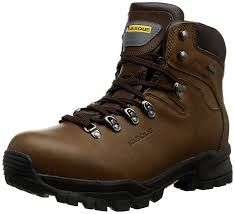 Backpacking Boots
Backpacking Boots
Backpacking boots are very durable and are designed for rough terrain, heavy loads and long backpacks. They have high uppers that wrap and support the ankles and a stiff durable sole that is suitable for off trail and very rugged terrain. Backpacking boots have aggressive treads that bite into the trail and use rubber compounds that last a long time but still grip well on rocks. They have evolved as well. Higher end backpacking boots have become increasingly light and breathable, and are comparable to hiking boots. Similarly, hiking boots have become more robust and durable, approaching the level of backpacking boots.
So what should I get, boots or shoes for hiking?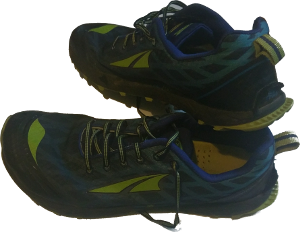
So which shoe for hiking is right for you? The answer is, it depends…
The big determinant is how new you are to tromping around in the world. Buying the best, lightweight boots you can reasonably afford, that provide the most protection and care for your feet is a good place to start. It is important early on to do what you can to insure that you have a good experience. Keeping your feet happy and injury free will go a long way to ensuring a safe and fun adventure. And it is really important to allow yourself time to learn the skills necessary to become an experienced hiker.

[…] liters or less: Most of these small packs are built for lightweight pursuits like running and ultralight hiking. Their compact and low-profile design provides room for only a handful of […]
link da web
The Trick to Getting Out There: Pick The Best Shoes For Hiking – travelore